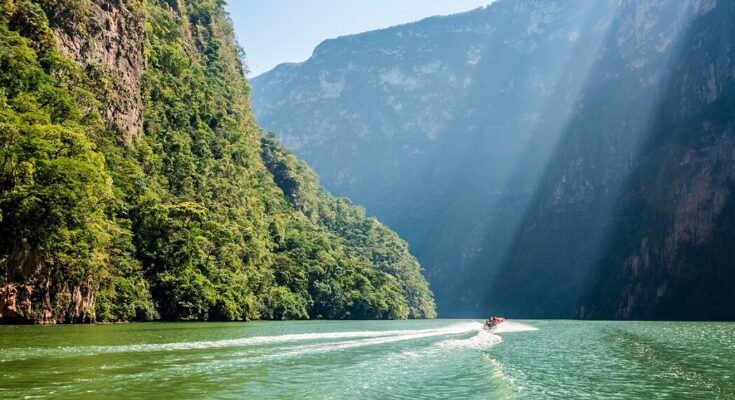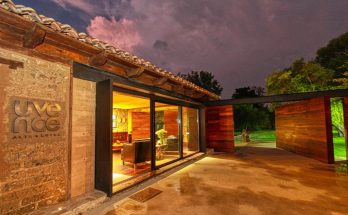The Mexican Republic has many tourist attractions and of course, among them are the natural landscapes that undoubtedly steal our breath, invite us to get lost in the adventure, trapping us to know them. Some of these are well known like the beaches of Cancun and others are totally mystical like the sanctuary of the monarch butterflies. There are really many options of natural attractions in Mexico and now we are going to know them.
Table of Contents
Natural landscapes of Mexico
Listing all the natural landscapes of Mexico can be a very impossible and complicated task. However: something we can do is to list those that are much more popular and right now we will tell you what they are, and it won’t be a list of the 10 best natural attractions in Mexico, it will be a list of the 30 best natural places you have to visit. So let’s get started.
Cancun – Quintana Roo
Cancun is located on the Yucatan Peninsula, which borders directly on the Caribbean Sea. This paradisiacal zone is famous for the beauty of its beaches, which have whitish sand and sea water that ranges from different shades of blue to turquoise.
A tourist site that puts you in direct contact with the great wonders of the Caribbean Sea, and if you only think of sun and refreshing drinks, do not forget that it is also known for its nightlife.

Riviera Maya – Quintana Roo
The Riviera Maya is located on the coast of the Caribbean Sea, precisely in the state of Quintana Roo. The large number of Mayan archeological sites and its excellent and exquisite gastronomy are other of its main attractions.
In the extreme south of the area, there is a reserve with semi-virgin spaces that show ecosystems of jungles, mangroves and beaches, known as the Sian Ka’an Biosphere Reserve.
Huasteca Potosina – San Luis Potosí
Huasteca Potosina is a region located in northeastern Mexico, in the state of San Luis Potosi, an ideal place for the practice of ecological tourism -also known as ecotourism-, trying activities with low doses of adrenaline such as hiking, camping, bird watching and canoeing.
The place has a wide extension, and that is due to the fact that during the pre-colonial times it was inhabited by locals and was part of an important trade route.

Sumidero Canyon – Chiapas
The Sumidero Canyon is a natural tourist destination that has become a huge place that is considered a sanctuary thanks to the large amount of natural and plant life that have taken the area as their own home.
In the area you will be able to observe all the birds that inhabit the place, whose spectacle is their melodious and velvety song. Don’t go to Mexico without visiting this site.
Cola de Caballo Waterfall – Nuevo León
This waterfall offers a unique experience surrounded by an incredible and colorful vegetation, the waterfall is 27 meters long and the water falls over the Sierra Madre Oriental.
In this tourist destination you can practice extreme sports with an additional cost, among them hanging bridges and zip lines.
Los Cabos – Baja California Sur
In Los Cabos you can enjoy a semi-dry and desert climate, in winter a temperate climate and in summer a hot one. Curiously, in winter you can witness one of the most beautiful natural phenomena that characterize the coasts of the country, which are the most important stages of the gray whale, courtship, procreation and birth.

Cuatrociénegas – Coahuila
Cuatrociénegas has recently become a Magical Town, in these same lands lived the Tobosos Indians, who were a warrior and nomadic community that traveled and inhabited the north of Mexico.
It is ideal for sightseeing, because you can observe in detail the old houses that hide characters wearing big hats, antique cars and much more.
Lacandon Jungle – Chiapas
This region stops in time to show how the lands looked like before our race existed, it becomes an imposing greenish extension with which you can delight thanks to its distinctive shapes and characteristics that make it a unique place in this world.
This jungle has climatic conditions of humid, semi-warm and warm character. Its fauna is extremely varied, you can observe species such as the jaguar, the iris-billed toucan, among others.
Arteaga Mountain Range – Coahuila
Its wooded landscapes are one of its main attractions, because they have a delicious aroma of fruits and visually you can enjoy the great mountain range.
The site has an impressive and elegant architecture, where you can stroll through the site finding numerous stores of different liquors and canned fruits that have been part of this town.
Veracruz Reef – Veracruz
It is considered and qualified as the only Gulf of the country, all and thanks to its extension, the amount of species that inhabit and the resilience of the magnificent coral colonies.
The coral reefs, besides being the main attraction of this park, are also the main object of conservation in the area, since they help to reduce the impact of hurricanes, storms and winds on the coast.

Eyipantla Waterfall – Veracruz
The Eyipantla Waterfall is about 60 meters high, whose waters finally flow into the Gulf of Mexico. This waterfall has 245 steps built to connect with its path.
Halfway down it is very likely to encounter a rainbow, giving off various tones thanks to its combination of water and light.
Popocatepetl and Iztaccihuatl – State of Mexico, Morelos and Puebla
The volcanoes in this area are more than 5,500 meters above sea level, and it is possible to practice hiking, cycling and mountaineering in certain areas. It is worth mentioning that the safest way to approach the volcanoes is in the direction of Puebla or Morelos, arriving at a refuge in Paso de Cortés.
Copper Canyon – Chihuahua
The Barrancas del Cobre are made up of a group of seven canyons that together form a natural tourist complex that is so impressive and is part of the view that the Rarámus Indians that inhabit the place receive.
This site is known as the most extensive mountain canyon system in the country, covering an area of 60 thousand square kilometers including canyons, gorges and ridges.

Celestún Estuary – Yucatán
In the Ría Celestún Biosphere Reserve, you can observe a fusion of salt and fresh waters, which makes this ecosystem a unique one that should be observed with attention, because it is composed of different sites where the experience is unforgettable, among them to the east of the Baldiosera Spring where you can swim and dive, Tambor, a place where you can admire the pink flamingo and much more.
El Cielo Biosphere Reserve – Tamaulipas
This site has 4 ecosystems that are still almost completely preserved in their original state, which is why many scientists research the area. It also has a wide variety of fauna and flora, which together make this site a memorable paradise.
In this paradisiacal place you can observe from afar how the clouds descend to a great height most of the year, which is due to its name, because it gives the illusion of being located closer to the sky.
Xel-Ha – Quintana Roo
In this park you will be able to get in touch with nature quickly, as you can walk through the jungle trails and visit the nursery, which has more than 270 species native to the area, so the fauna is one of the biggest attractions in this place.
The bodies of fresh water join the Caribbean Sea forming a rich and grandiose ecosystem where you can take an unforgettable walk among thousands of colorful fish and aquatic plants among coral reefs.
Definitely a place you need to visit at least once in your life.
Nevado de Toluca – State of Mexico
It is a mountain that is catalogued as a sacred site, and among its multiple lagoons have been found items of great archaeological importance, such as resins, vegetables, fibers, wood and others, which provides relevant information about the pre-Hispanic cultures.
The Sun and Moon Lagoons can be found inside its crater, the highest registered lagoons of their species – Alpine Perennial Lakes – contrasting with the dry and arid landscape thanks to its clear and turquoise blue waters.

Peña de Bernal – Querétaro
Bernal is recognized as a Magical Town and a place to take refuge in search of tranquility. The Peña de Bernal is the third largest monolith in the world, and thanks to several studies, it has been possible to know its origin: A volcano whose activity was exhausted, its lava inside solidified and as a result of erosion, the remains of the volcano have disappeared.
Pico de Orizaba – Veracruz and Puebla
The Pico de Orizaba -also known as Citlaltépetl- is a volcano that is currently inactive, being the only volcano in the world to have frozen lava in its interior. At the summit, its surface is covered with snow all year round thanks to its extensive altitude.
The volcano belongs to two orographic systems: the Sierra Madre Oriental and the Neovolcanic Axis. It is located between the states of Veracruz and Puebla.
Naica Mine – Chihuahua
This is a cave that is characterized by its giant crystals of Naica, whose dimensions reach 13 meters in length and weigh more than 50 tons, so this site offers a tourist experience out of nature.
Recent discoveries have confirmed the existence of microorganisms that feed on these minerals and others, being probably new species in the eyes of science.
Ten years after its discovery, it could be declared as World Heritage of the country, being a treasure under the ground that now has its due protection and care.
These gypsum minerals that have been growing all this time are located in the municipality of Saucillo in the Mexican state of Chihuahua.
Monarch Butterfly Sanctuary – Michoacán
This sanctuary offers a unique spectacle to observe, a journey of thousands of kilometers made by monarch butterflies, which undertake their journey from the United States and Canada to the forests of Michoacan to hibernate for about two months and then resume their journey back home.
You can’t miss one of the largest migrations in nature, as millions of butterflies make this enormous journey. Scientists have not yet found a logical explanation that can explain this round trip, but it is undeniable that nature is impressive and mesmerizing.

Paricutín – Michoacán
It is a volcano that is currently inactive, recognized as the only volcano belonging to the twentieth century that has a birth certificate. In one of its ancient expulsions, the lava buried two towns: Paricutín and San Juan Parangaricutiro, the first disappeared completely when it was near the crater, for which it was given its name, and the second was renamed Nuevo San Juan when it was reinstalled in a neighboring place.
There is a lot of information about this eruption, it is known that in its first 24 hours the volcano could rise about 30 meters high, and when it reached its third day it would cover about 60 meters of extension on the ground, and a month later it reached 148 meters. At the moment it has 424 meters of extension.
Montebello Lakes – Chiapas
A tourist site that is unique in its type due to its lakes of different colors and tones, which turns it into a site with a magical nature, its extension is of 6 thousand 22 hectares and it was created in 1959 with the purpose of being part of the conservation of forests, soils and lagoons, finally being a tourist center.
And the fact is that Chiapas has an enormous diversity of species, it has more than 75 thousand kilometers of land that varies between different complete ecosystems, such as pine and oak forests, rivers, colorful lakes, memorable waterfalls and high jungles that preserve a lively and colorful green.
Arteaga Mountain Range – Coahuila
The Sierra de Arteaga is composed of the sierras of Los Lirios, Las Vigas and Siberia, being a perfect place for climbing, an activity performed by the people of Nuevo León and Coahuila every weekend. Here you can admire a wide variety of pine, cedar and oak species, not to mention the animal life.
Great Mayan Reef – Quintana Roo
It is considered as the second most beautiful reef in the world, housing in its interior a vast ecosystem in which you can observe how the dynamics of nature have mixed to make a whole new unknown territory.
Its exact length is unknown, but it is believed that it may measure more than a thousand kilometers in extension.
Nayarit Riviera – Nayarit
The Riviera Nayarit consists of a corridor that expands along the entire length of the Pacific Ocean coast. The experience is not based on material luxury, but on unique experiences and experiences in contact with nature, walking along its virgin beaches, which are delimited by jungle hills and magical towns.
It has crystalline waters and palm trees that reach kilometers in length, Magical Towns and a miniature Galapagos that is located in the most remote islands of the site.

Dzitnup Cenote – Yucatán
It is a site that has a medium sized cave that connects with a tight tunnel that leads to a beautiful and clear blue water cenote, a place where you can practice various activities such as snorkeling and swimming.
You can observe the “entrance of the sun” in the place, which is practically an opening in the roof of the cave where an entrance is located in the upper area of the cave, creating a magical vision.
It is considered a site of gods, reserving its name as “blue cave”.
Los Cabos Beaches – Baja California Sur
A place that promises to take you directly to the “end of the earth”, meeting with El Arco, which is a rock formation that originates from the sea, being a great attraction to be able to pass through this opening.
Its beaches have warm sands, offering a unique experience just 100 meters from El Arco.
Camécuaro Lake – Michoacán
It is known for its natural beauty, for having crystal clear waters, in addition to having vegetation surrounding the lake. An ideal place to capture nature in its maximum splendor, because in its crystalline waters you can observe the vegetation under it, giving a greenish and lively image. Its waters are received by several springs in the area.
Camping in its surroundings is the most impressive thing, because they have an extensive and flat area perfect to do so.
Waterfalls of Agua Azul – Chiapas
Thanks to the different carbonates that are dissolved in its waters, the waterfalls have a striking and attractive bluish tone, and the same minerals of these waters petrify trunks and produce natural formations that are directed to the currents. These are located 215 km from the capital of Chiapas.
It is a protected reserve at present thanks to the fruit of its carbonate salts that dissolve later in the limestone riverbed, these waterfalls are formed by the inflows and abundance of water from the Otulún, Shumuljá and Tulijá rivers.

Conclusion
We could talk about the 100 best natural attractions in Mexico, or the 200 or the 500, but as you can see, it would take us many letters and time, so we hope this small list is ideal for you and of course, see you soon in another post of Traveling By.
Tags:




